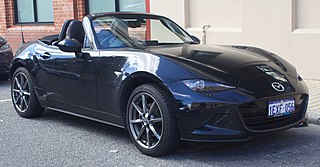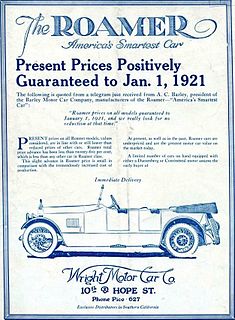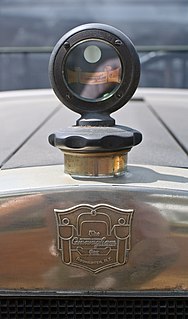The Sun automobile was made in Elkhart, Indiana from 1916 to 1917, and in Toledo, Ohio from 1921 to 1922.

Elkhart is a city in Elkhart County, Indiana, United States. The city is located 15 miles (24 km) east of South Bend, Indiana, 110 miles (180 km) east of Chicago, Illinois, and 150 miles (240 km) north of Indianapolis, Indiana. Elkhart has the larger population of the two principal cities of the Elkhart-Goshen Metropolitan Statistical Area, which in turn is part of the South Bend-Elkhart-Mishawaka Combined Statistical Area, in a region commonly known as Michiana. The population was 50,949 at the 2010 census. Despite the shared name, it is not the county seat of Elkhart County; that position is held by the city of Goshen, located about 10 miles (16 km) southeast of Elkhart.

Toledo is a city in and the county seat of Lucas County, Ohio, United States. Toledo is in northwest Ohio, at the western end of Lake Erie bordering the state of Michigan. The city was founded in 1833 on the west bank of the Maumee River, and originally incorporated as part of Monroe County, Michigan Territory. It was re-founded in 1837, after conclusion of the Toledo War, when it was incorporated in Ohio.
The Sun Motor Car Company was originally created in Buffalo, New York, but moved to Elkhart before production began. Their slogan was "The Sun Outshines Them All". Roscoe C. Hoffman designed a lightweight six-cylinder car, manufactured from 1916 to 1917. There were four body styles offered on the 116-inch (2946 mm) wheelbase: sedan, roadster, 5 person touring and 7 person touring. It made 23 horsepower though the company dubiously claimed 50. The car had shaft drive and a three-speed sliding gear transmission, and was priced in the $1000 range. Sun Motor Cars ordered 3,500 engines under contract from the Beaver Manufacturing Company of Milwaukee, Wisconsin, but since a little over 1,100 cars were made in the two years, the company was in receivership by September 1917. The company's assets were purchased by the Automotive Corporation of Toledo, Ohio.

Buffalo is the second largest city in the U.S. state of New York and the largest city in Western New York. As of July 2016, the population was 256,902. The city is the county seat of Erie County and a major gateway for commerce and travel across the Canada–United States border, forming part of the bi-national Buffalo Niagara Region.

In both road and rail vehicles, the wheelbase is the distance between the centers of the front and rear wheels. For road vehicles with more than two axles, the wheelbase is the distance between the steering (front) axle and the centerpoint of the driving axle group. In the case of a tri-axle truck, the wheelbase would be the distance between the steering axle and a point midway between the two rear axles.

A roadster is an open two-seat car with emphasis on sporting appearance or character. Initially an American term for a two-seat car with no weather protection, usage has spread internationally and has evolved to include two-seat convertibles.
The Sun automobile of Toledo was a small two-seat roadster, with power coming from a 12 hp (9 kW) four-cylinder engine, produced in 1921 and 1922 only. It featured a 91-inch (2311 mm) wheelbase, disc wheels, and a claimed 50 miles per US gallon (4.7 L/100 km; 60 mpg‑imp) and 50 mph (80 km/h).
The Automotive Corporation had built tractors in Toledo since shortly before the end of World War I. After taking over Sun Motor Car Company, Automotive Corporation provided parts and service to Sun owners, as well as gained useful experience in automobile manufacturing. Their new car of 1921 shared nothing with the old Sun except the logo. Even the slogan was new: "America's Greatest Little Car". Not only were the engines smaller, so was the wheelbase and price-- $375 in 1921 and $475 in 1922. A new lineup with bigger engines, longer wheelbases, and higher prices were announced but never produced for 1923.

World War I, also known as the First World War or the Great War, was a global war originating in Europe that lasted from 28 July 1914 to 11 November 1918. Contemporaneously described as "the war to end all wars", it led to the mobilisation of more than 70 million military personnel, including 60 million Europeans, making it one of the largest wars in history. It is also one of the deadliest conflicts in history, with an estimated nine million combatants and seven million civilian deaths as a direct result of the war, while resulting genocides and the 1918 influenza pandemic caused another 50 to 100 million deaths worldwide.
The Ace was an American-assembled car made in Ypsilanti, Michigan by the Apex Motor Car Company, which was reorganized as the Apex Motor Corporation in 1921. The initial batch of cars assembled were sent to Seattle, Washington dealer FE Earnest, who had the idea for the Ace after he was unable to secure a steady supply of new cars for his dealership.

The Alter Motor Car Company, of Plymouth, Michigan, produced over 1,000 automobiles between 1914 and 1916.

Templar was a manufacturer of automobiles in Lakewood, Ohio from 1917 to 1924. The company was named for the Knights Templar and used a Maltese Cross as an emblem.

The Lexington was an automobile manufactured in Connersville, Indiana, from 1910 to 1927. From the beginning, Lexingtons, like most other Indiana-built automobiles, were assembled cars, built with components from many different suppliers. The Thoroughbred Six and Minute Man Six were popular Lexington models.

Willys-Knight is an automobile that was produced between 1914 and 1933 by the Willys-Overland Company of Toledo, Ohio.

The Westcott was an automobile produced in Richmond, Indiana and Springfield, Ohio in the United States between 1909 and 1925 by the Westcott Motor Car Company. The car company was named for its founder, John Westcott.

Barley Motor Car Co. was a manufacturer of automobiles in Kalamazoo, Michigan, and Streator, Illinois. It manufactured the Roamer automobile (1916–29) and, briefly, the Barley (1922–24), and the Pennant (1924–25).
The Jacquet Flyer was an American automobile manufactured only in 1921. It was built in Belding, Michigan by the Jacquet Motor Corporation of America. A sports car which sold for a fairly high price, it had a 124-inch (3,100 mm) wheelbase; wire wheels were standard. The cars, few of which were made, were powered by four-cylinder Wisconsin engines of 6.2L capacity; the only model offered was a two-passenger roadster.

The Lambert automobile and Lambert truck were built by the Lambert Automobile Company as an American vehicle from 1905 through 1916. The Lambert automobile motor in the early part of manufacturing moved around on the chassis. It was on the back of the chassis, then in the center, then to the front, and back again to the rear of the automobile. The early motors were built at the Lambert factories of the Buckeye Manufacturing Company and later they were outsourced to other proprietary manufactures.
The Friend was an automobile manufactured in Pontiac, Michigan by the Friend Motors Corporation in 1920. Otis Friend had taken over the Olympian Motor Company in 1920, and manufactured that car until the car named after himself was ready. The Friend was shown at the New York Automobile Show in January 1921, featured a four-cylinder engine, a 112-inch (2842mm) wheelbase, and had a five-seater, two-door roadster body. Wooden artillery and wire wheels were options. The Friend originally sold for $1585. With sales sluggish, the price was reduced further to $1185, but this had no effect, and production ended with fewer than fifty cars built. A six-cylinder model was planned, but the company went out of business before any were manufactured.
The Austin was a brass era American automobile manufactured in Grand Rapids, Michigan from 1901 to 1921. The company, founded by James E. Austin and his son Walter Austin, built large, expensive and powerful touring cars with an unusual double cantilever rear spring arrangement placing the rear wheels behind the passenger compartment, for a longer wheelbase to improve rider comfort in an era of rough roads as well as a unique two-speed rear axle.

The Cole Motor Car Company was an early automobile maker based in Indianapolis, Indiana. Cole automobiles were built from 1908 until 1925. They were quality-built luxury cars. The make is a pioneer of the V-8 engine.
The Yale was a Brass Era car manufactured in Saginaw, Michigan from 1916 to 1918, not to be confused with the Yale from Toledo, Ohio.

The Cunningham automobile was a pioneering American production automobile, one of the earliest vehicles in the advent of the automotive age. It was produced from 1896 to 1931 in Rochester, New York by James Cunningham, Son and Company.

The Jewel Motor Car Company of Massillon, Ohio manufactured the Jewel automobile from 1906 to 1909.

The Commonwealth Motors Corporation was a luxury auto company that produced cars from 1917 to 1922. The company was founded in Chicago as Partin-Palmer company in 1913, but in 1915 got into financial trouble. So, in 1917, the name was changed to Commonwealth, and production was moved to Joliet, Illinois.
The Ogren Motor Car Company was a car maker based in Chicago and Waukegan, Illinois from 1915 to 1917, then in Milwaukee, Wisconsin from 1920 to 1923).

The Winther was an automobile manufactured in Winthrop Harbor, Illinois and Kenosha, Wisconsin, USA, by the Winther Motors Sales Corporation between 1920 and 1923. The company had been building trucks and fire appliances since 1917, and decided to broaden its production.
The Driggs was an automobile manufactured by the Driggs Ordnance & Manufacturing Corporation of New Haven, Connecticut between 1921 and 1923.
The Multiplex was an automobile built in Berwick, Pennsylvania by the Multiplex Manufacturing Company from 1912 to 1913. The Multiplex was a sporty, upper-prized and large car equipped with a four-cylinder engine, and offered as a Touring, a Roadster, and a Raceabout. A prototype "Sports" car with an 85 inches (2,200 mm) wheelbase, weighting in at just 980 pounds (440 kg) and allegedly capable of a top speed of 126 mph (203 km/h) was also built.


















